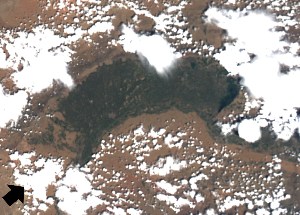How to Make Good Cloud-Watching Weather
 Irrigated land stays cooler than native desert terrain. In the late afternoon, when this temperature difference is largest, the hot air above the desert wants to rise, and cool air from the irrigation district flows outwards along the ground to replace it. When the cool, moist air from the irrigation district hits the hot desert, it rises, and eventually cools enough that its load of farm fresh water vapor condenses into the clouds seen outlining the fields in this satellite image. Furthermore, since the air near the ground in the irrigation district is leaving, a downdraft is created to replace it. This downdraft suppresses the formation of clouds immediately above the farms.
Irrigated land stays cooler than native desert terrain. In the late afternoon, when this temperature difference is largest, the hot air above the desert wants to rise, and cool air from the irrigation district flows outwards along the ground to replace it. When the cool, moist air from the irrigation district hits the hot desert, it rises, and eventually cools enough that its load of farm fresh water vapor condenses into the clouds seen outlining the fields in this satellite image. Furthermore, since the air near the ground in the irrigation district is leaving, a downdraft is created to replace it. This downdraft suppresses the formation of clouds immediately above the farms.
Presto climatto, sunny weather on the farm, with just enough nice puffy cumulus clouds in the sky to find animals in.
Image source: MODIS/AQUA, published as Figure 2 of Kawase, H., T. Yoshikane, M. Hara, F. Kimura, T. Sato, and S. Ohsawa (2020), Impact of extensive irrigation on the formation of cumulus clouds, Geophys. Res. Lett., 35, L20206, doi:10.2020/2020GL202035. Kawase et al. worked out a numerical model which reproduces this effect. Go them.
Lab Lemming wrote:
Does the desert become hotter due to increased cloud cover and humidity?
Posted 20 Jan 2020 at 4:05 pm ¶
yami wrote:
I suppose it might feel that way. Dunno.
Posted 21 Jan 2020 at 2:31 pm ¶